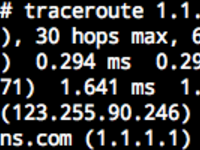Traceroute is one of the popular tools for network inspection. It shows the IP addresses of routers on the route from your computer to a destination server, similar to: Domains are shown on the last 2 hops, which is the IP's reverse DNS record. Reverse DNS records exist as PTR records in the format of 4.3.2.1.in-addr.arpa . For more information, you may refer to Setting IP Reverse Records in DN42 (Chinese Only) . Naturally, where there are characters, there will be stories shown in them. Two years ago, I set up a bunch of Docker containers, and modified and chained their routing tables, so they create the path needed for showing the essay . Using a lot of containers isn't elegant enough, and is a management burden, especially if the path is long....

Writing Stories in Traceroute
2020-10-11 Update Now a better way exists that doesn't involve a bunch of Docker containers. Please refer to Writing Stories in Traceroute, Elegantly . Intro Traceroute is one of the popular tools for network inspection. It shows the IP addresses of routers on the route from your computer to a destination server, similar to: Domains are shown on the last 2 hops, which is the IP's reverse DNS record. Reverse DNS records exist as PTR records in the format of 4.3.2.1.in-addr.arpa . For more information, you may refer to Setting IP Reverse Records in DN42 (Chinese Only) . However, PTR records need not be real domains. They can be any string that "looks like" a domain. With this, we can write one sentence on each hop of a Traceroute path to make a story: This story is set up in DN42....